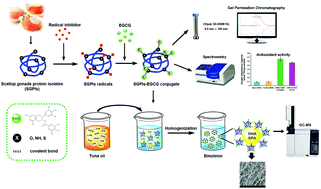Fabrication of surface-active antioxidant biopolymers by using a grafted scallop (Patinopecten yessoensis) gonad protein isolate–epigallocatechin gallate (EGCG) conjugate: improving the stability of tuna oil-loaded emulsions†
Abstract
The oxidation of unsaturated fats generally occurs at the oil–water interface of emulsions, so surface-active antioxidants are needed for inhibiting lipid oxidation. In this study, a scallop gonad protein isolate (SGPI)–epigallocatechin gallate (EGCG) conjugate was fabricated and characterized as an amphiphilic surface-active antioxidant in improving the physicochemical and oxidative stability of tuna oil-loaded emulsions via a free-radical grafting method. The covalent binding of EGCG to SGPIs was verified by using electrophoresis and gel permeation chromatography. Meanwhile, the structural, physical, thermal, as well as the in vitro antioxidant properties of the SGPI–EGCG conjugate were further characterized. The results indicated that the SGPI–EGCG conjugate contained more β-sheet but less α-helix than SGPIs, leading to the changes of the secondary and tertiary conformation stability after conjugation. The radical scavenging and oxygen radical absorbance capacity of SGPIs were significantly increased by 4.9 times and 7.4 times, respectively, after the EGCG-grafting reaction. Compared with that stabilized by SGPIs, tuna oil emulsions emulsified by the SGPI–EGCG conjugate exhibited a smaller particle size and better storage stability. Furthermore, the SGPI–EGCG conjugate inhibited lipid and fatty acid oxidation during storage more significantly in tuna oil emulsions than SGPIs due to its higher interfacial accumulation and antioxidant activities. These results suggested that the SGPI–EGCG conjugate could be utilized as an efficient surface-active antioxidant and emulsifier for the encapsulation and protection of unsaturated lipids.



 Please wait while we load your content...
Please wait while we load your content...